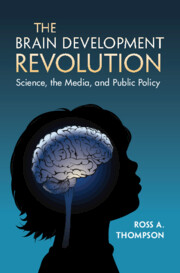Book contents
- The Brain Development Revolution
- The Brain Development Revolution
- Copyright page
- Contents
- Figures
- Preface
- Chapter 1 Science Does Not Speak for Itself
- Chapter 2 The Supreme Court Considers Adolescence
- Chapter 3 Dispatches from the Laboratory
- Chapter 4 I Am Your Child
- Chapter 5 “Follow the Science”
- Chapter 6 Framing Developmental Science
- Chapter 7 Who Speaks for Developmental Science?
- Notes
- Works Cited
- Index
- About the Author
Chapter 4 - I Am Your Child
Published online by Cambridge University Press: 24 August 2023
- The Brain Development Revolution
- The Brain Development Revolution
- Copyright page
- Contents
- Figures
- Preface
- Chapter 1 Science Does Not Speak for Itself
- Chapter 2 The Supreme Court Considers Adolescence
- Chapter 3 Dispatches from the Laboratory
- Chapter 4 I Am Your Child
- Chapter 5 “Follow the Science”
- Chapter 6 Framing Developmental Science
- Chapter 7 Who Speaks for Developmental Science?
- Notes
- Works Cited
- Index
- About the Author
Summary
The I Am Your Child campaign in 1997 introduced the public to early brain development and shaped public understanding of the developing brain. In its design and impact, it illustrates “campaign journalism” that mobilizes public engagement through a large-scale communications strategy that weds science and advocacy and creates media momentum. This approach bypasses traditional science journalism and foreshadowed the current era of advocacy through viral social media messaging. This chapter documents the events leading up to the campaign, its planning and central themes, the events, its impact on parents, and the reactions of commentators. The chapter profiles how developmental scientists responded both critically and constructively, and describes the report of a federal blue-ribbon committee formed in response, From Neurons to Neighborhoods: The Science of Early Childhood Development. In assessing the campaign and its impact, the chapter shows how the messaging integrated neuroimaging studies with research on children’s behavioral development in ways that were both helpful and misleading to public understanding; how cultural frames shaped how the messaging was received and accepted; and the problems deriving from the selectivity of the campaign’s messaging, including insufficient attention to prenatal development, brain growth after early childhood, and the effects of poverty.
Keywords
Information
- Type
- Chapter
- Information
- The Brain Development RevolutionScience, the Media, and Public Policy, pp. 104 - 137Publisher: Cambridge University PressPrint publication year: 2023
